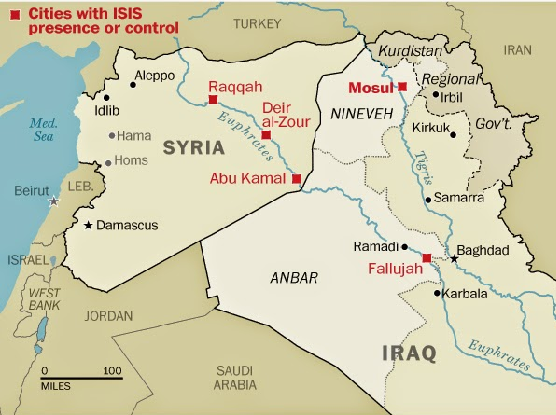Over the last several years, figuring out whose side America is fighting on in both Iraq and Syria has not always been easy, but in recent weeks that task has become impossible. Instead of hedging bets on a prospective victor in the conflicts raging in either country, the US is apparently content to back all sides.
Shipments of American weapons to Syrian Kurds began Wednesday, fulfilling plans announced earlier this month. While the Pentagon refuses to disclose what weapons they are sending, officials familiar with the shipments say they will likely involve a few armored vehicles, light arms and ammunition. The Kurds in question are part of the multi-ethnic, US-backed Syrian Democratic Forces (SDF) and are slated to participate in an operation to expel the Islamic State from Raqqa, the group’s self-proclaimed capital city.
The Turks are not happy with this move, as they view the American-backed Kurds as an extension of the PKK (the Kurdistan Workers’ Party), a political party in Turkey that is on the country’s terrorism list and that has fought intermittently with the Turkish government since the late 1970s. Turkey hopes to convince Washington to abandon its Kurdish proxies in favor of a force of 10,000 Turkish-backed rebels, but it isn’t yet clear if the American administration is ready to do that.
“We told [Washington] there are many alternatives for Raqqa and they didn’t disagree,” one Turkish official familiar with the situation told Reuters. “They said ‘we understand your sensitivities, we don’t recognize [the YPG’s] territorial ambitions.’” The YPG is a Kurdish militia active in Syria, one of the main groups comprising the SDF and the recipient of the American arms delivered Wednesday.
Two days after the Trump administration announced its plans to arm Kurdish fighters, it also told Turkish officials it would support them in their fight with the PKK. While that does not augur any change in the decision to back the Syrian Kurds, America’s alliance with these two avowed enemies has put U.S. policy on what some have called a collision course.
Meanwhile in Iraq, the United States fights alongside Iran-backed Shi’ite militias, commonly known as Popular Mobilization Forces (PMFs) in the effort to push ISIS out of its urban stronghold in Mosul. The PMFs have acted as a supplementary force to the larger Iraqi army, but the militias have at times played a more significant role in the fight against ISIS. Just this Monday a PMF liberated several Iraqi villages from ISIS control, and earlier on in the operation to take Mosul PMFs assisted the Iraqi Security Forces with clearing areas around the city.
Just a few miles west, in Syria, the United States is arming its rebel fighters in order to fend off those very same Shi’ite militias, or at least groups with similar allegiances and a similar ideology. This is done in the name of curtailing Iranian influence in the region, but it amounts to placing a major roadblock in front of the Syrian government’s own push against the Islamic State.
The Shi’ite militias in Iraq and Syria are currently trying to link up to secure a vital surface supply route via the Damascus-Baghdad highway, a route that would also help the Syrian government coordinate its attack on Raqqa. The US, however, appears ready to scuttle any attempt made to secure the highway, even bombing a Shi’ite militia convoy allied with the Syrian government on May 18. This two-faced policy could hardly be more blatant.
In Northern Syria, moreover, the United States has resumed support for Free Syrian Army rebels, who have been fighting with the Syrian regime for years. The groups will operate in Idlib, the western portion of the Aleppo Province and parts of Latakia. One FSA commander denied reports that the rebels would be fighting the al-Qaeda-dominated Hay’at Tahrir al-Sham, confirming that the US has resumed anti-regime operations.
The Trump administration announced in late March that regime change in Syria was off the table, but barely one week later launched a punitive Tomahawk missile strike in response to an alleged regime chemical weapons attack in the town of Khan Sheikhun. The chemical attack was never proven to have been carried out by the regime, but who ever needed facts to justify military action?
Further afield, in the southern Gulf state of Yemen, Uncle Sam carries out occasional strikes on AQAP – or what Yemeni journalist Nasser Arrabyee terms “Qaeda-ISIS” – but also gives vital assistance to a Saudi-led coalition that bombs al-Qaeda’s most capable opponent in the country, the Houthis. Here we have another self-defeating policy, backing multiple sides of the same conflict.
The Saudi air campaign on Yemen has killed thousands of non-combatants, devastated civilian infrastructure and propelled the country into a humanitarian disaster. Over half of Yemen’s population is food insecure, and Yemenis are now ill-equipped to handle basic medical ailments, let alone a recent cholera outbreak.
Defense Secretary Mattis recently told the press Iran was a destabilizing influence in Yemen, yet the absurdity in that claim is revealed by the thousands of dead civilians, bombed out infrastructure and crumbling economy caused not by Iran, but by American-made munitions, dropped from American-made planes fueled and maintained by American contractors and supported diplomatically by American politicians, who run interference for Saudi starvation tactics. If that doesn’t meet the definition of “destabilizing,” nothing does.
Iran’s support for the Houthis is nowhere near what is alleged, even explicitly urging the group to abort plans to take Yemen’s capital in 2014, however as the conflict drags on the Islamic Republic may decide to step up aid to its besieged ideological cousins, fulfilling Mattis’ prophecy.
The US is now backing rebels to overthrow the Syrian government, and simultaneously fighting the regime’s greatest enemy, the Islamic State. At the same time, America fights alongside Assad-friendly Shi’ite militias taking on ISIS in Iraq, but seeks to diminish their gains next door in Syria, where the militias fight ISIS on behalf of Assad. Support for the Kurds will likely continue, but only with simultaneous cooperation with their Turkish nemesis; while in Yemen, the U.S. backs several opposing sides of the war ravaging that country.
Add to the heap possible plans for long-term American presence in Eastern Syria, and you’ve got a recipe for disaster. How many contradictory policies can you squeeze into one conflict?
Perhaps retired CIA officer Phil Giraldi is correct when he says America has no foreign policy, since the term implies a coherent set of ideas and a few sensible plans. These, as we have seen, America does not have.
[This article was originally published at The Daily Sheeple.]






